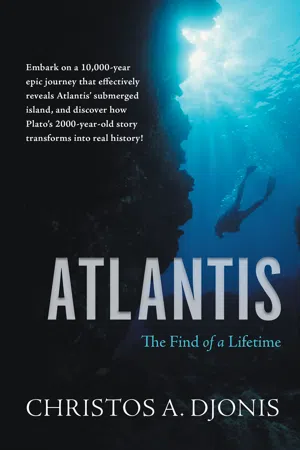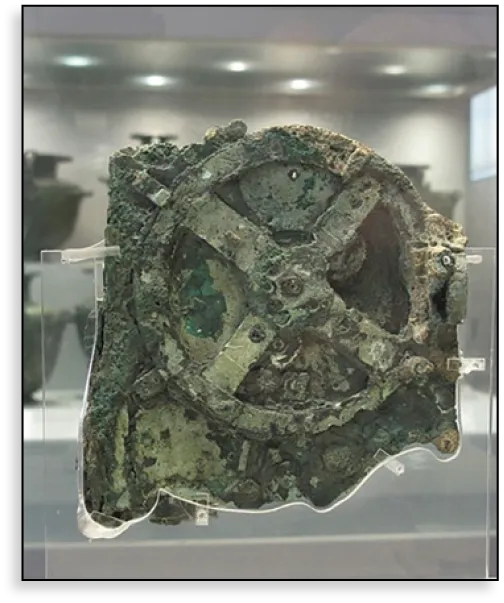![]()
Atlantis Revealed
Was the Great Flood a Real Event?—Was North America Colonized by a Mediterranean Culture 11,000 Years Ago?—The Kennewick Man.
Did a Bronze Age Visitor Help the Mayan Establish Their Civilization?
The Metcalf Stone. Who Were the Minoans?—Atlantis Revealed.
The Great Sphinx: Older Than the Pyramids? Who Erected Stonehenge? The Meaning Behind the Stone Circles of Europe. Who Were the Clovis People? The Phaistos Disc.
While the twentieth century brought to us some of the most incredible scientific breakthroughs humanity ever witnessed, we must not discount the fantastic achievements and technological wonders left behind by past human civilizations. Aside from the several megalithic monuments antiquity left behind, there are also many smaller marvels of ancient ingenuity that confront our awareness and demonstrate our ancestors’ exceptional technological abilities.
Excavations on the Greek island of Santorini (Thera) revealed that the 3,600-year-old Bronze Age city of Akrotiri featured advanced multilevel housing structures with indoor plumbing, complete with sewer and water supply lines for both hot and cold water.
This discovery is incredible because up until recently, we were under the impression that it was the Romans who were first able to utilize such technology, nearly 1,500 years later.
The Bronze Age city of Akrotiri on the island of Santorini (Thera) Greece
What about the Antikythera Mechanism (an extremely complex device designed to calculate astronomical positions at any given moment in time)? It was found at the bottom of the Aegean Sea near the Greek island of Antikythera, hence its name. Made of several bronze wheels and other mechanical components more than 2,000 years ago, this device is so incredible that, at first glance, it resembles a twentieth-century piece of equipment. Indeed, when it was first discovered, it was mistaken as such. An x-ray of the mechanism revealed that instruments of this complexity were not known to exist at least until the seventeenth century.
Who designed and constructed this remarkable device or how this technology was lost afterward is not entirely clear. Labeled by scientists as the first mechanical computer in history, this incredible feat of engineering required that its maker had advanced knowledge of astronomy, as well as a diverse knowledge in mechanics and machine making.
The Antikythera Mechanism displayed at the National Archaeological Museum of Athens, Greece
After 75 years deciphering the mechanism, researchers concluded that the ancient device was used as a type of timepiece, based on a geocentric view of the universe. However, instead of hours and minutes, it displayed celestial time and had different hands for the Sun, the Moon, and the five planets visible to the naked eye (Mercury, Venus, Mars, Jupiter, and Saturn). A rotating ball showed the Moon, while dials’ phase on the back acted as a calendar and showed lunar and solar eclipses. Captions explained which stars rose and set on any particular date. The most incredible part about this mechanism is that the mechanical gears’ precision, which accurately showed all planetary motions, was based on mathematics.
How accurate was the ancient computer, one may ask? It is believed that the planetary motion was accurate to one degree in 500 years.
Professor Michael Edmunds of Cardiff University, who led the most recent study of the mechanism, said,
This device is just extraordinary, the only thing of its kind. The design is beautiful, the astronomy is exactly right. The way the mechanics are designed just makes your jaw drop. Whoever has done this has done it extremely carefully…in terms of historic and scarcity value, I have to regard this mechanism as being more valuable than the Mona Lisa.1
Another one of the many yet unexplained artifacts that continuously raises eyebrows and stirs many debates among the scientific community is the famous Baghdad Battery. This primitive version of a modern battery made from clay vessels, copper tubes, and the right alkaline fluid could produce electricity nearly 2,000 years ago.
In 1938, while working in Khujut Rabu, just outside Baghdad in modern-day Iraq, German archaeologist Wilhelm Konig unearthed the ancient artifact, a 5-inch-long clay jar containing a copper cylinder that encased an iron rod. The container showed signs of corrosion, and early tests revealed that an acidic agent, such as vinegar or wine, had to be stored in it. Many replicas made over time, including by university students, proved that the Baghdad batteries could actually conduct an electric current.
What was the purpose of the electricity produced by these batteries, and where did this knowledge come from, no one really knows. Until their discovery, we were under the impression that battery technology was an eighteenth-century invention.
One more ancient invention by the Greeks that led to the “discovery” of the modern steam engine was the aeolipile, also known as Hero’s engine. The aeolipile, described in detail by Hero of Alexandria in the first century BC, is considered the first-ever recorded steam engine or reaction steam turbine device. The name—derived from the Greek word Αἴολος (Aeolus) and the Latin word pila—translates to “the ball of Aeolus,” Aeolus being the Greek god of the air and wind. The mechanism was a simple, radial steam turbine that spins when the central water container is heated. The torque is produced by steam jets exiting the turbine, much like a rocket engine.
A modern replica of the Hero’s engine
With every new find, without a doubt, our ancestors continue to demonstrate that several millennia ago, they were extremely knowledgeable and more technologically advanced than we have been giving them credit for. How, though, did they come across their incredible knowledge? How could they possess skills that, until recently, we thought were acquired during the Industrial Revolution? Were these really brand-new skills, or is it possible that we evolved much earlier in time and slowly developed many of our technological capabilities over the millennia, long before our recorded history? If so, if truly our ancestors had advanced thousands of years earlier than anthropologists previously thought, then what happened to all past human development?
The story of a “Great Flood” sent by God (or gods according to much earlier testimony) to destroy humanity for its “sins” is a widespread account shared by many religions and cultures around the world, and it dates back to our earliest recorded history. From India to ancient Greece, Mesopotamia, and even among North American Indian tribes, there is no shortage of such tales that often enough sound very much alike. Some of these stories sound so similar that one could wonder whether all cultures around the world had experienced such an event. Or is it possible they influenced each other by storytelling over the millennia?
Can it be that all flood accounts so zealously repeated around the world are a collection of myths or isolated incidents? Or was the Great Flood a single worldwide cataclysm that affected all humanity at one point during our prehistory? While small isolated disasters can stress and frighten affected populations equally, their overall effect is short-lived, and they often fade from memory within decades, if not years. In the case of the Great Flood, however, we have a story that seems to have no boundaries and one that every ancient culture insists on its worldwide nature. How big and how destructive, though, was such a disaster that managed to sear itself into our ancestors’ collective memory for thousands of years? Judging by the shared testimony, this must not only have been an event that affected everyone simultaneously, but for it to have become a permanent fixture in the human psyche, it must have been an experience that persisted not only for days or months but for several generations.
Today, although science accepts that regional floods have indeed adversely affected many ancient populations over the millennia, it still denies that there was ever a single deluge that affected every civilization on the planet at once. Meanwhile, as the type, chronology, and magnitude of such an event are still highly debated, several scientific theories of the Great Flood are currently in circulation, and more of them continue to surface from time to time.
In recent years, and according to a published study in 1997 by William Ryan and Walter Pitman, the Great Flood story was linked to the “sudden flood” of the Black Sea. According to their hypothesis, at around 5,600 BC, the melting of the glaciers—along with several other significant hydrologic factors that included the flow of rivers and heavy rainfall—caused the Mediterranean Sea level to rise so rapidly that it ultimately and violently flooded the Black Sea, making it into the body of water we know today.
Ryan and Pitman speculated that the Mediterranean’s flooding occurred via a massive waterfall, nearly two hundred times larger than that of Niagara Falls, which daily dumped 10 cubic miles of seawater into the Black Sea for 300 days. By the time it was over, 60,000 square miles around the Black Sea had been submerged. This was the best evidence we had for nearly a decade to explain the Great Flood story. Although more of a regional flood, undoubtedly, such an event could have utterly destroyed any established civilization around the Black Sea during this period and rightfully so could have been labeled as a Great Flood by those who experienced it.
Unfortunately for the Ryan and Pitman team, though, another study was conducted since reported differently. Although the later research agreed to the premise of the Black Sea being flooded, it contradicted the severity of the flood as well as the chronological time of the event. In 2005, a research project under UNESCO’s spo...



